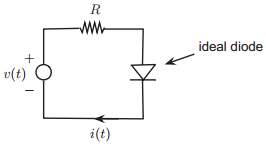The voltage-current characterization of a p-n diode is given by (see Figure 2.22) i(t) = I s
Question:
i(t) = Is(eqv(t)/kTˆ’1)
where i(t) and v(t) are the current and the voltage in the diode (in the direction indicated in the diode) Is is the reversed saturation current, and kT/q is a constant.
(a) Consider the voltage v(t) as the input and the current i(t) as the output of the diode. Is the p-n diode a linear system? Explain.
(b) An ideal diode is such that when the voltage is negative, v(t) < 0, the current is zero, i.e., open circuit; and when the current is positive, i(t) > 0, the voltage is zero or short circuit. Under what conditions does the p-n diode voltage-current characterization approximate the characterization of the ideal diode? Use MATLAB to plot the current-voltage plot for a diode with Is = 0.0001 and kT/1 = 0.026 and compare it to the ideal diode current-voltage plot. Determine if the ideal diode is linear.
(c) Consider the circuit using an ideal diode in Figure 2.23, where the source is a sinusoid signal v(t) = sin(2Ï€ t) u(t) and the output is the voltage in the resistor R = 1 or vr(t). Plot vr(t). Is this system linear? Where would you use this circuit?
Figure 2.22:

Figure 2.23:

Step by Step Answer:






